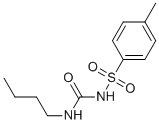All AbMole products are for research use only, cannot be used for human consumption.

Tolbutamide is used along with diet and exercise, and sometimes with other medications, to treat type 2 diabetes Tolbutamide belongs to a class of medications called sulfonylureas. Tolbutamide lowers blood sugar by causing the pancreas to produce insulin (a natural substance that is needed to break down sugar in the body) and helping the body use insulin efficiently. This medication will only help lower blood sugar in people whose bodies produce insulin naturally. Tolbutamide is not used to treat type 1 diabetes (condition in which the body does not produce insulin and, therefore, cannot control the amount of sugar in the blood) or diabetic ketoacidosis (a serious condition that may occur if high blood sugar is not treated). Tolbutamide inhibits both the basal and the cyclic AMP-stimulated protein kinase activities and the IC50 of Tolbutamide is 4 mM, and inhibits glucagon-induced phosphorylation of the bifunctional enzyme protein in a dose-dependent manner. Tolbutamide treatment significantly increases the binding of insulin to isolated adipocytes. The effect is associated with an enhanced response to insulin of the adipose tissue, since the fat cells obtained from animals treated with Tolbutamide convert significantly more glucose to lipids in the presence of insulin than those obtained from the control group .
| Cell Experiment | |
|---|---|
| Cell lines | C6 glioma cells |
| Preparation method | Before each experiment, incubating C6 glioma cells in serum-free DMEM at 37 °C for at least 24 hours . Tolbutamide (400 μM) is incubated for 24 hours in serum-free medium. Incubations are performed at 37 °C in an atmosphere of 95% air/5% CO2 with 90–95% humidity |
| Concentrations | 400 μM |
| Incubation time | 24 hours |
| Animal Experiment | |
|---|---|
| Animal models | Male albino Wistar rats (200-300 g) |
| Formulation | Tolbutamide is given as powder and mixed with food. |
| Dosages | 450 mg/kg |
| Administration | Tolbutamide is administered orally for 7 days. |
| Molecular Weight | 270.35 |
| Formula | C12H18N2O3S |
| CAS Number | 64-77-7 |
| Solubility (25°C) | DMSO 42 mg/mL |
| Storage |
Powder -20°C 3 years ; 4°C 2 years In solvent -80°C 6 months ; -20°C 1 month |
| Related Potassium Channel Products |
|---|
| Palmitoyl-L-carnitine chloride
Palmitoyl-L-carnitine chloride (L-Palmitoylcarnitine chloride) is a long-chain acylcarnitine and a fatty acid metabolite, accumulates in the sarcolemma and deranges the membrane lipid environment during ischaemia. Palmitoyl-L-carnitine chloride inhibits KATP channel activity, without affecting the single channel conductance, through interaction with Kir6.2. |
| VU0810464
VU0810464 is a potent and selective non-ureaG protein-gated inwardly-rectifying potassium channels (GIRK, Kir3) activator. VU0810464 displays nanomolar potency for neuronal (EC50=165 nM) and GIRK1/4 (EC50=720 nM) channels with improved brain penetration. |
| QO 58
QO 58 is a potent modulator of K(v)7 channels. |
| NS3623
NS3623 is an activator of human ether-a-go-go-related gene (hERG1/KV11.1) potassium channels. |
| ML67-33
ML67-33 is a selective activator of temperature- and mechano-sensitive K2P channels. |
All AbMole products are for research use only, cannot be used for human consumption or veterinary use. We do not provide products or services to individuals. Please comply with the intended use and do not use AbMole products for any other purpose.


Products are for research use only. Not for human use. We do not sell to patients.
© Copyright 2010-2024 AbMole BioScience. All Rights Reserved.
